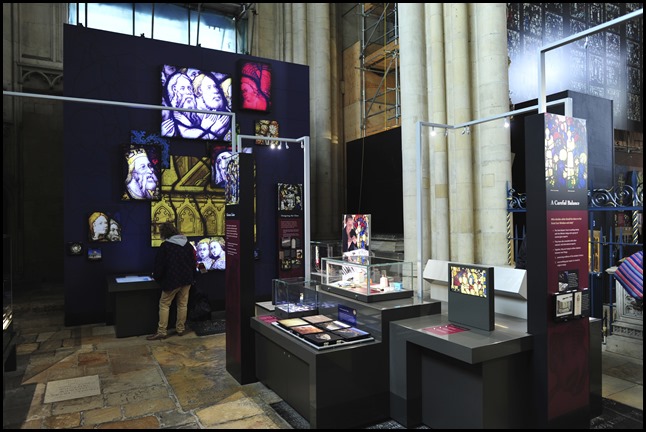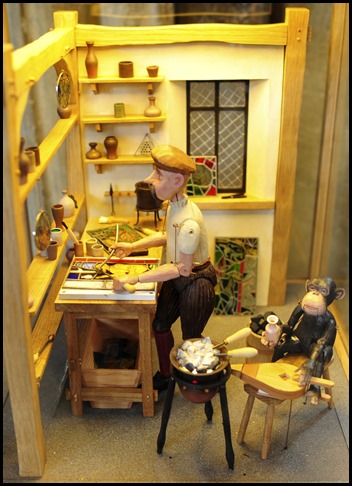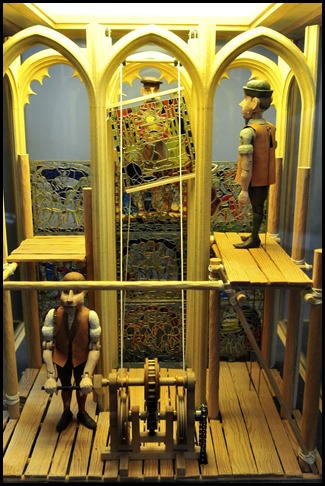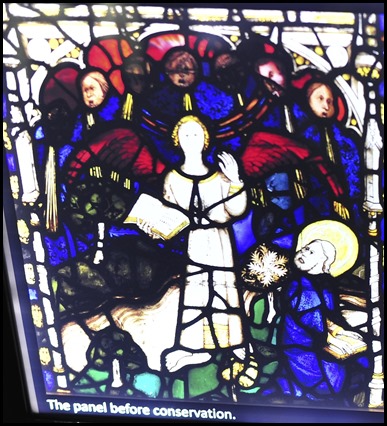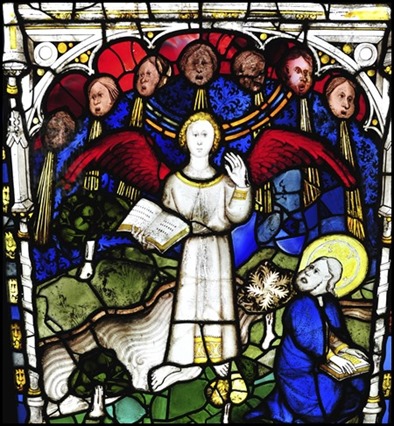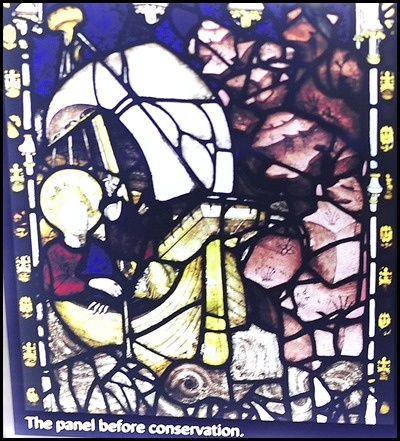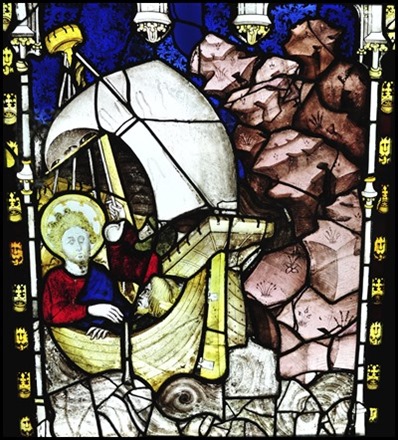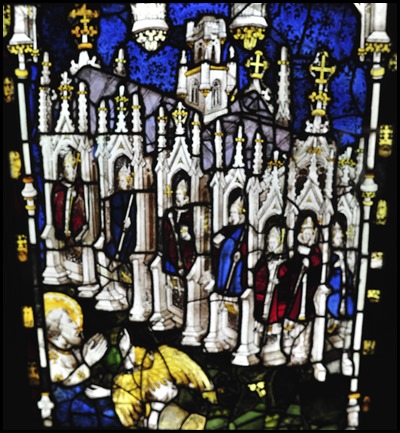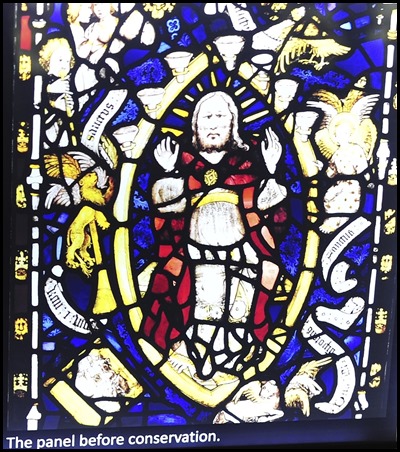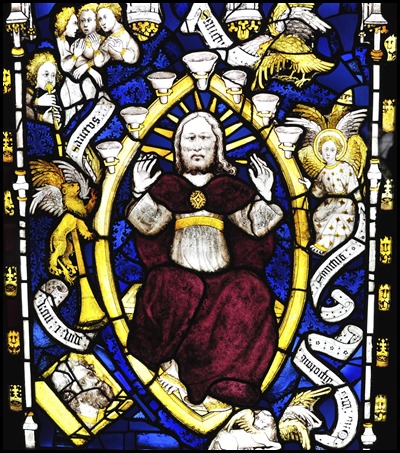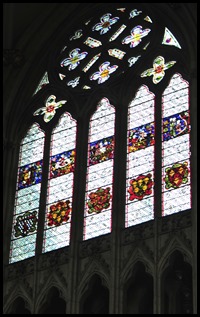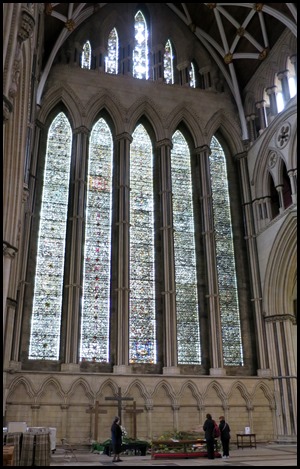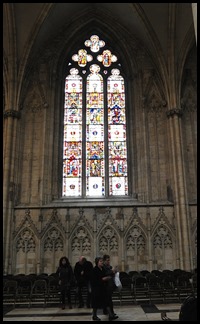Stained Glass

|
The Stained Glass of York Minster
 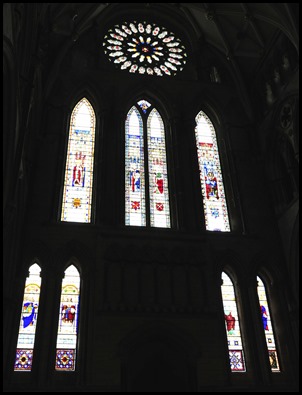 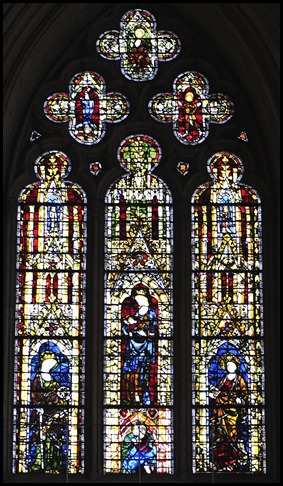 York as a whole, and particularly the minster, have a
long tradition of creating beautiful
stained
glass. Some of the stained glass in York Minster dates back to
the 12th century. The Minster's records show that much of the glass (white or
coloured) came from Germany. Upon arrival at York, it was intricately painted,
fired then glazed together with lead strips into the windows. The seventy six
foot tall Great East Window, created by John
Thornton in the early 15th century, is the largest expanse of
medieval stained glass in the world. Other windows in the minster
include an ornate rose
window and the fifty foot tall Five Sisters window. Because of
the extended time periods during which the glass was installed, different types
of glazing and painting techniques which evolved over hundreds of
years are visible in the different windows. Approximately two million individual
pieces of glass make up the cathedral's one hundred and twenty eight stained
glass windows. Much of the glass was removed before and pieced back together
after the First and Second World
Wars, and the windows are constantly being
cleaned and conserved to keep their beauty intact.
In 2008 a major conservation project of the Great East Window commenced, involving the removal, repainting and re-leading of each individual panel. While the window was in storage in the minster's stonemasons' yard, a fire broke out in some adjoining offices, due to an electrical fault, on the 30th of December 2009. The window's three hundred and eleven panes, stored in a neighbouring room, were undamaged and were successfully moved to safety.
There was a really interesting display about the windows of the Minster.
The Great East Window presents a biblical vision of the beginning and end of the world. Since 1408 it has astonished worshippers and visitors. John Thornton was paid fourteen pounds to personally design the window and paint the key parts. This was a colossal sum of money. The largest conservation programme of its kind in Europe is now revealing its original magnificence. In 1685, visitor Celia Fiennes noted in her diary: In the Minster there is the greatest curiosity for windows I ever saw........ those in the Quire at the end and on each side that is three storeys high and painted very curious, with history of the Bible. The painting is very fine...... but the loftiness of the windows is more than I ever saw anywhere else, and by all accounts is peculiar. We saw it as a picture curtain and an old print. It is about the same size as a tennis court. The window contains one of the largest single areas of medieval stained glass in the world.
Sixteen miles of tubing and seventeen thousand fittings has gone into the scaffolding at the East Front of the Minster. Conserving just one glass panel would take one conservator six hundred hours or four working months to restore, at a cost of twenty five thousand pounds. The whole window is expected to be completed by the year 2016.
Looking at the window plan, there is an awful lot of work involved.
4c. The First Vial: So the fist angel went and poured his bowl on the earth, and foul and painful sore came on those who had the mark of the beast and worshipped its image. The Scene: Revelation 16:2. An angel with blue wings flies at the top of the panel and pours out the vial onto the earth. Five figures below, wearing detailed robes or fashionable hats, writhe in pain. This panel is remarkably well preserved. Conservation Highlight: This panel required very conservation. The scene benefits from the new thinner leads.
8g. The Mighty Angel and the Seven Thunders – And I saw another mighty angel coming down from heaven.... Setting his right foot on the sea and his left foot on the land, he gave a great shout, like a lion roaring. And when he shouted, the seven thunders sounded. The scene: Revelation 10:1-7. Saint John is kneeling at the right. He turns as the angel instructs him not to write down what the seven thunders at the top of the panel said. Conservation Highlight: Two of the original thunders’ heads have been lost. Conservators have created a new head – third from left, based on the others. They have kept an 1820’s copy head – second from right, but turned it the right way.
11b. Saint John Sailing to Patmos – I, John........ was on the island called Patmos..... I was in the spirit on the Lord’s day, and I heard behind me a loud voice like a trumpet saying, “Write in a book what you see.....” The Scene: The Roman Emperor Domitian has banished Saint John to Patmos for preaching the Christian faith. On this tiny island – off the coast of modern Turkey, John will experience his vision of the end of the world. Conservation Highlight: Conservators removed many pieces of old repair lead in the rocks and the sea. Now you can see clearly how the ship is in danger of being smashed against the towering cliffs of the island.
11f. The Seven Churches. As for the mystery of the seven stars that you saw in my right hand, and the seven golden lampstands: the seven stars are the angels of the seven churches, and the seven lampstands are the seven churches. The Scene: Revelation 1:20. Saint John, bottom left, is told by an angel to write to the seven churches of Asia about his vision. John Thornton’s glazing design is unique as it combines all seven churches in one image. Each is represented by the archbishop standing in a shrine-like building. Conservation Highlight: The glass pieces are very small and intricately cut. Conservators have removed heavy repair lead from the 1950’s, revealing much more detail.
11h. Saint John Glimpses God in Majesty. After this I looked, and there in heaven a door stood open! And the voice, which I had heard speaking to me like a trumpet, said, “Come up here, and I will show you what must take place after this.” The Scene: Revalation 4:1-9. Saint John looks through a kind of trapdoor at the bottom left. God, in the centre, has summoned him to heaven to show him eternity. Written on the scrolls are words of eternal praise offered to God by the four creatures. Conservation Highlight. Conservators have used historical evidence to restore God’s purple cloak, which had become patched with a jumble of different colours.
ALL IN ALL QUITE A CHALLENGE AN ENORMOUS CONSERVATION EFFORT |
